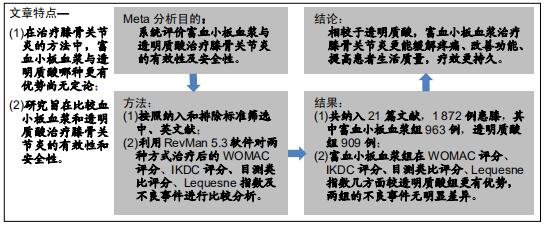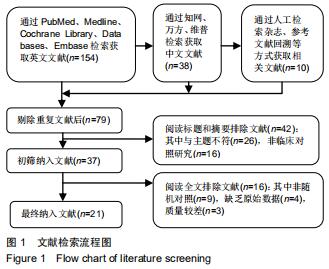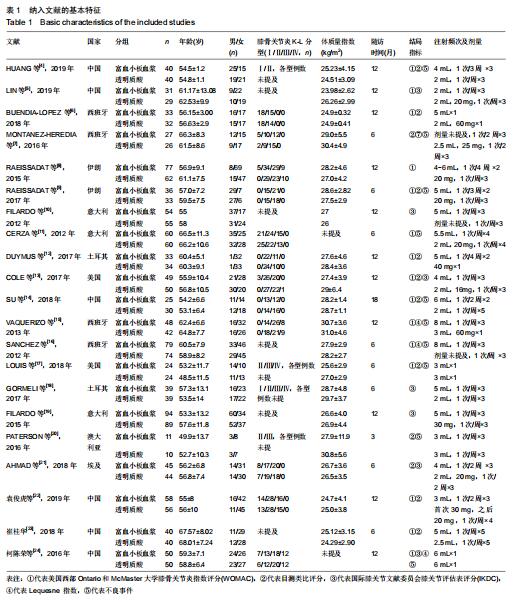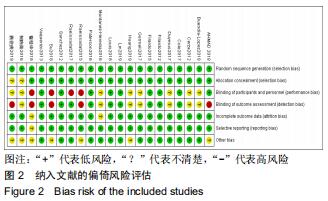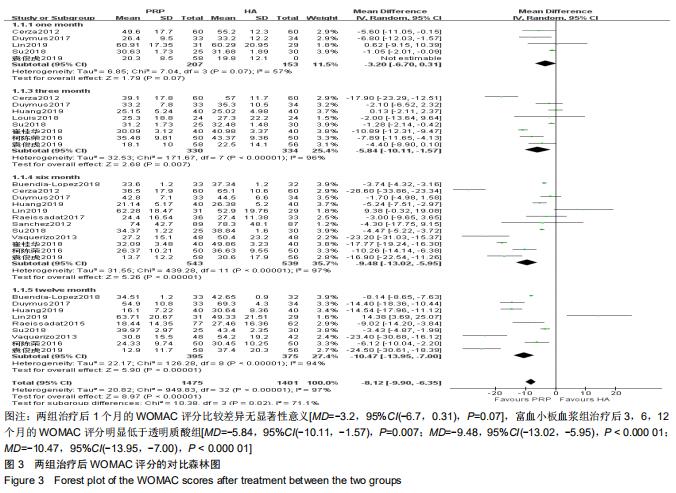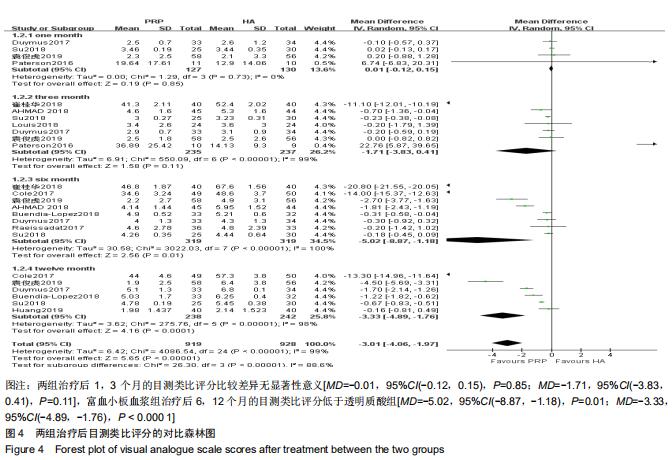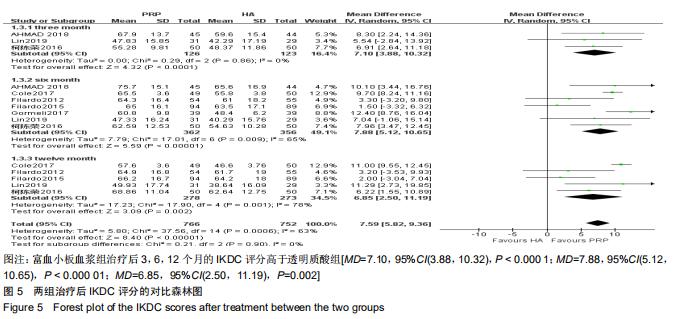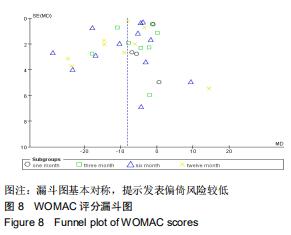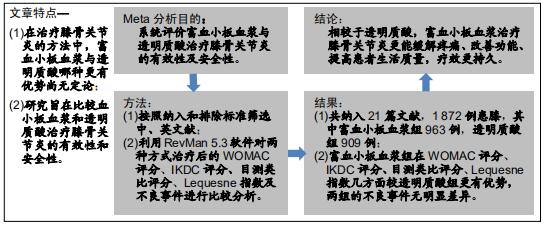|
[1] MCALINDON TE, BANNURU RR. Osteoarthritis in 2017: Latest advances in the management of knee OA.Nat Rev Rheumatol.2018;14(2):73-74.
[2] CONAGHAN PG. NSAIDs or paracetamol for short-term treatment of mild to moderate knee pain in early osteoarthritis: are they equivalent?Evid Based Med.2016;21(1):14.
[3] VAN BUUL GM, KOEVOET WL, KOPS N, et al. Platelet-rich plasma releasate inhibits inflammatory processes in osteoarthritic chondrocytes.Am J Sports Med. 2011;39(11): 2362-2370.
[4] HUANG Y, LIU X, XU X, et al. Intra-articular injections of platelet-rich plasma, hyaluronic acid or corticosteroids for knee osteoarthritis.Der Orthopäde.2019;48(3):239-247.
[5] LIN KY, YANG CC, HSU CJ, et al. Intra-articular Injection of Platelet-Rich Plasma Is Superior to Hyaluronic Acid or Saline Solution in the Treatment of Mild to Moderate Knee Osteoarthritis: A Randomized, Double-Blind, Triple-Parallel, Placebo-Controlled Clinical Trial. Arthroscopy. 2019;35(1): 106-117.
[6] BUENDIA-LOPEZ D, MEDINA-QUIROS M, FERNANDEZ-VILLACANAS MM. Clinical and radiographic comparison of a single LP-PRP injection, a single hyaluronic acid injection and daily NSAID administration with a 52-week follow-up: a randomized controlled trial.J Orthop Traumatol. 2018;19(1):3.
[7] MONTAÑEZ-HEREDIA E, IRÍZAR S, HUERTAS P, et al. Intra-Articular Injections of Platelet-Rich Plasma versus Hyaluronic Acid in the Treatment of Osteoarthritic Knee Pain: A Randomized Clinical Trial in the Context of the Spanish National Health Care System.Int J Mol Sci.2016;17(7):1064.
[8] RAEISSADAT SA, RAYEGANI SM, HASSANABADI H, et al. Knee Osteoarthritis Injection Choices: Platelet- Rich Plasma (PRP) Versus Hyaluronic Acid (A one-year randomized clinical trial).Clin Med Insights Arthritis Musculoskelet Disord. 2015;8:1-8.
[9] RAEISSADAT SA, RAYEGANI SM, AHANGAR AG, et al. Efficacy of Intra-articular Injection of a Newly Developed Plasma Rich in Growth Factor (PRGF) Versus Hyaluronic Acid on Pain and Function of Patients with Knee Osteoarthritis: A Single-Blinded Randomized Clinical Trial. Clin Med Insights Arthritis and Musculoskelet Disord. 2017; 10:1179544117733452.
[10] FILARDO G, KON E, DI MARTINO A,et al.Platelet-rich plasma vs hyaluronic acid to treat knee degenerative pathology: study design and preliminary results of a randomized controlled trial.BMC Musculoskelet Disord.2012; 13:229.
[11] CERZA F, CARNI S, CARCANGIU A, et al. Comparison Between Hyaluronic Acid and Platelet-Rich Plasma, Intra-articular Infiltration in the Treatment of Gonarthrosis. Am J Sports Med.2012;40(12):2822-2827.
[12] DUYMUS TM, MUTLU S, DERNEK B, et al. Choice of intra-articular injection in treatment of knee osteoarthritis: platelet-rich plasma, hyaluronic acid or ozone options.Knee Surg Sports Traumatol Arthrosc.2017;25(2):485-492.
[13] COLE BJ, FORTIER LA, KARAS V, et al. Hyaluronic Acid versus Platelet-Rich Plasma: Double-blind Randomized Controlled Trial Comparing Clinical Outcomes and Intra-Articular Biology for Treatment of Knee osteoarthritis.Am J Sports Med.2017;45(2):339-346.
[14] SU K, BAI Y, WANG J, et al. Comparison of hyaluronic acid and PRP intra-articular injection with combined intra-articular and intraosseous PRP injections to treat patients with knee osteoarthritis.Clin Rheumatol.2018;37(5):1341-1350.
[15] VAQUERIZO V, PLASENCIA MÁ, ARRIBAS I, et al. Comparison of Intra-Articular Injections of Plasma Rich in Growth Factors (PRGF-Endoret) Versus Durolane Hyaluronic Acid in the Treatment of Patients With Symptomatic Osteoarthritis: A Randomized Controlled Trial.Arthroscopy. 2013;29(10):1635-1643.
[16] SÁNCHEZ M, FIZ N, AZOFRA J, et al. A Randomized Clinical Trial Evaluating Plasma Rich in Growth Factors (PRGF-Endoret) Versus Hyaluronic Acid in the Short-Term Treatment of Symptomatic Knee Osteoarthritis. Arthroscopy. 2012;28(8):1070-1078.
[17] LOUIS ML, MAGALON J, JOUVE E, et al. Growth Factors Levels Determine Efficacy of Platelets Rich Plasma Injection in Knee Osteoarthritis: A Randomized Double Blind Noninferiority Trial Compared With Viscosupplementation. Arthroscopy.2018;34(5):1530-1540.
[18] GÖRMELI G, GÖRMELI CA, ATAOGLU B, et al. Multiple PRP injections are more effective than single injections and hyaluronic acid in knees with early osteoarthritis: a randomized, double-blind, placebo-controlled trial. Knee Surg Sports Traumatol. Arthroscopy.2017;25(3):958-965.
[19] FILARDO G, Di MATTEO B, Di MARTINO A, et al.Platelet-Rich Plasma Intra-articular Knee Injections Show No Superiority Versus Viscosupplementation.Am J Sports Med. 2015;43(7):1575-1582.
[20] PATERSON KL, NICHOLLS M, BENNELL KL, et al. Intra-articular injection of photo-activated platelet-rich plasma in patients with knee osteoarthritis: a double-blind, randomized controlled pilot study.BMC Musculoskelet Disord. 2016;17(1).
[21] AHMAD HS, FARRAG SE, OKASHA AE, et al. Clinical outcomes are associated with changes in ultrasonographic structural appearance after platelet-rich plasma treatment for knee osteoarthritis.Int J Rheum Dis.2018;21(5):960-966.
[22] 袁俊虎,陈扬,魏鲁青,等.富含血小板血浆与常规药物关节腔注射治疗早期膝骨关节炎的临床疗效比较[J].骨科,2019,10(1): 25-30.
[23] 崔桂华.富血小板血浆与透明质酸钠治疗膝骨关节炎的效果比较[J].中国当代医药,2018,25(16):102-104.
[24] 柯陈荣,张睿,薛继鑫.富血小板血浆联合透明质酸关节腔内注射治疗膝骨关节炎疗效分析[J].中华全科医学,2016,14(11): 1810-1812.
[25] BIJLSMA JW, BERENBAUM F, LAFEBER FP. Osteoarthritis: An update with relevance for clinical practice.Lancet. 2011; 377(9783):2115-2126.
[26] WANG B, LIU W, XING D, et al. Injectable nanohydroxyapatite-chitosan-gelatin micro-scaffolds induce regeneration of knee subchondral bone lesions.Sci Rep. 2017; 7(1):16709.
[27] MCALINDON TE, BANNURU RR, SULLIVAN MC, et al. OARSI guidelines for the non-surgical management of knee osteoarthritis. Osteoarthritis Cartilage.2014;22(3):363-388.
[28] HAWKER GA, MIAN S, BEDNIS K, et al. Osteoarthritis year 2010 in review: non-pharmacologic therapy.Osteoarthritis Cartilage.2011;19(4):366-374.
[29] SÁNCHEZ M, ANITUA E, AZOFRA J, et al. Intra-articular injection of an autologous preparation rich in growth factors for the treatment of knee OA: a retrospective cohort study.Clin Exper Rheumatol.2008;26(5):910.
[30] GOBBI A,LAD D, KARNATZIKOS G. The effects of repeated intra-articular PRP injections on clinical outcomes of early osteoarthritis of the knee.Knee Surg Sports Traumatol Arthrosc. 2015;23(8):2170-2177.
[31] 王波,余楠生.膝骨关节炎阶梯治疗专家共识(2018年版)[J].中华关节外科杂志(电子版),2019,13(1):124-130.
[32] BELLAMY N. Pain assessment in osteoarthritis: Experience with the WOMAC osteoarthritis index.Semin Arthritis Rheum. 1989;18(4-supp-S2):14-17.
[33] HIGGINS LD, TAYLOR MK, PARK D, et al. Reliability and validity of the International Knee Documentation Committee (IKDC) Subjective Knee Form.Joint Bone Spine. 2007;74(6): 594-599.
[34] MANICOURT DH, AZRIA M, MINDEHOLM L, et al. Oral salmon calcitonin reduces Lequesne's algofunctional index scores and decreases urinary and serum levels of biomarkers of joint metabolism in knee osteoarthritis.Arthritis Rheumatol. 2006;54(10):3205-3211.
[35] 袁涛,席刚,韩鹏飞,等.关节腔内注射PRP与HA治疗膝关节骨性关节炎的荟萃分析[J].中国矫形外科杂志,2019,27(3):235-242.
[36] HAN YH, HUANG HT, PAN JK, et al. Comparison of platelet-rich plasma vs hyaluronic acid injections in patients with knee osteoarthritis: A protocol for a systematic review and meta-analysis.Medicine.2018;97(44):e13049.
[37] TEXTOR JA, WILLITS NH, TABLIN F. Synovial fluid growth factor and cytokine concentrations after intra-articular injection of a platelet-rich product in horses.Vet J. 2013; 198(1):217-223.
[38] GOBBI A, LAD D, KARNATZIKOS G. The effects of repeated intra-articular PRP injections on clinical outcomes of early osteoarthritis of the knee. Knee Surg Sports Traumatol Arthrosc. 2015;23(8):2170-2177.
[39] KIM SJ, KIM EK, KIM SJ, et al. Effects of bone marrow aspirate concentrate and platelet-rich plasma on patients with partial tear of the rotator cuff tendon.J Orthop Surg Res. 2018; 13(1):1.
[40] CUGAT R, CUSCÓ X, SEIJAS R, et al. Biologic Enhancement of Cartilage Repair: The Role of Platelet-Rich Plasma and Other Commercially Available Growth Factors. Arthroscopy. 2015;31(4):777-783.
|
